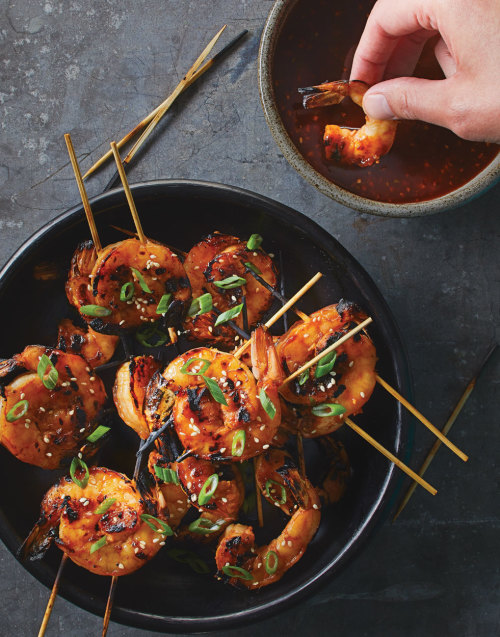All About Shrimp: Buying, Cleaning, Cooking & Recipes
Shrimp is arguably the most popular seafood in North America. And picking out good-quality shrimp isn’t hard; you’re already equipped with the best tools to make good choices — your senses.
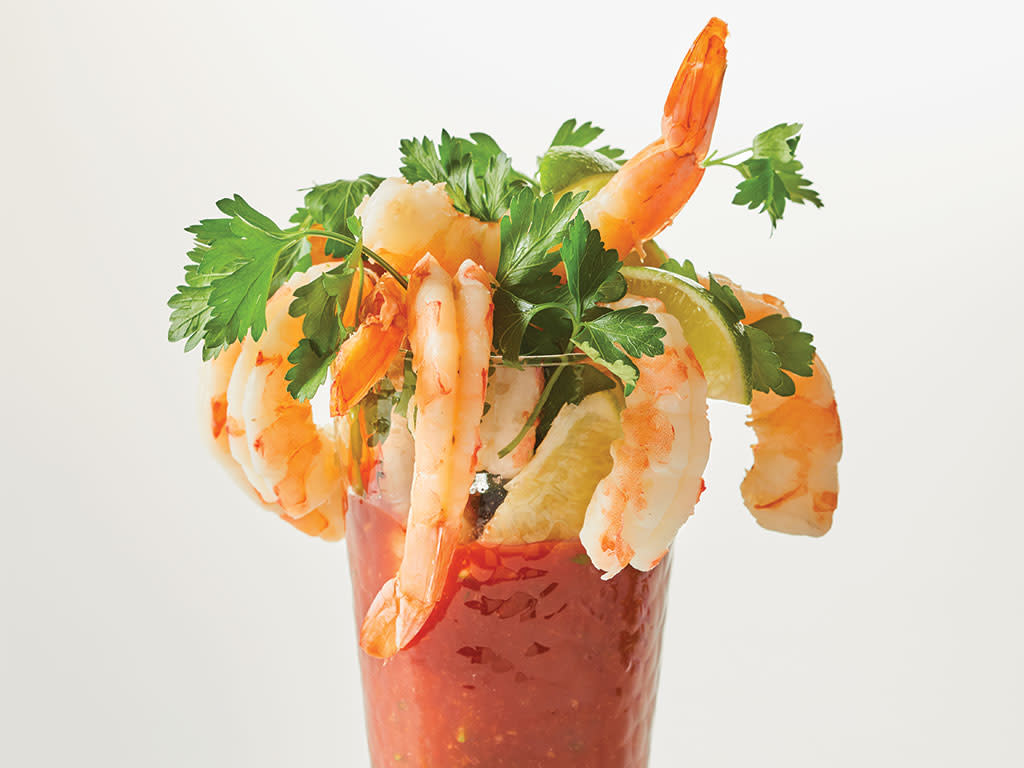
WHAT ARE SHRIMP AND WHERE DO THEY COME FROM?
Shrimp are related to lobster (both are crustaceans) and are harvested worldwide. They’re typically divided into three groups: warm-water, cold-water, and freshwater species. Since fresh-water shrimp represent a small percentage of the market, this article refers only to warm- and cold-water shrimp. Warm-water shrimp come from, no surprise, warm areas — the Gulf of Mexico, the South Atlantic, and Southeast Asia. Coldwater shrimp are found in the Pacific Northwest and North Atlantic. Also called “tiny” or “salad” shrimp (over 70 per lb.), this variety occupies a small portion of the retail market and is almost always sold precooked in cans or in the deli or freezer sections of the grocery store.
Shrimp are either caught in the ocean or raised on farms; the harvesting method should be indicated on the package. Most wild shrimp are found in the Gulf of Mexico or South Atlantic waters. Because they swim freely in the ocean, wild shrimp don’t contain the food additives that farmed shrimp may be subjected to. They also tend to cost more. Farmed shrimp are raised primarily outside the U.S. The practice is controversial because the waste it generates can have a negative impact on the environment. However, some producers are taking steps to lessen farming’s detrimental effects. Wild shrimp have more ocean-like flavor, but farmed varieties can be just as good.
PURCHASING & STORING SHRIMP
Shrimp come in a variety of prepared states (shells on or off; heads and tails on or off; cooked or raw). For optimum flavor, your best bet is to buy them raw, headless, and with the tail and shell left on. Peeling away the shell and removing the “vein,” or digestive tract isn’t difficult (see steps, below).
It’s best to buy frozen shrimp, then thaw in cold water as needed. If buying thawed shrimp from the market, be sure to use your senses, as noted, below. To store thawed shrimp, place plastic wrap over ice in a bowl, top with shrimp, cover them loosely with plastic wrap, and chill. Once thawed, they’re good for 2–3 days.
SMELL First and foremost, use your nose when buying shrimp. All you should smell is the sweet, mild aroma of clean ocean. If there is a bad odor or ammonia smell, stay away. This indicates that the shrimp are beginning to spoil.
COLOR Look out for black spots or rings on the shell or meat (except tiger shrimp) — an indication of deterioration. Also avoid meat or shells that are yellow. This is a result of too much sodium bisulfite, a chemical used to prevent black spots.
TEXTURE Rely on your sense of touch. Good shrimp should be firm, not mushy. The shells don’t necessarily have to be firm. Shrimp periodically shed their shells, and the new shells that form tend to be soft. But you don’t want the shells to be slimy (or gritty) — another indication of spoilage
SHRIMP SIZING EXPLAINED
Shrimp are sized by how many make up a pound. 16/20s mean there are 16 to 20 shrimp per pound. Sizing can vary, so the names are merely a guide.
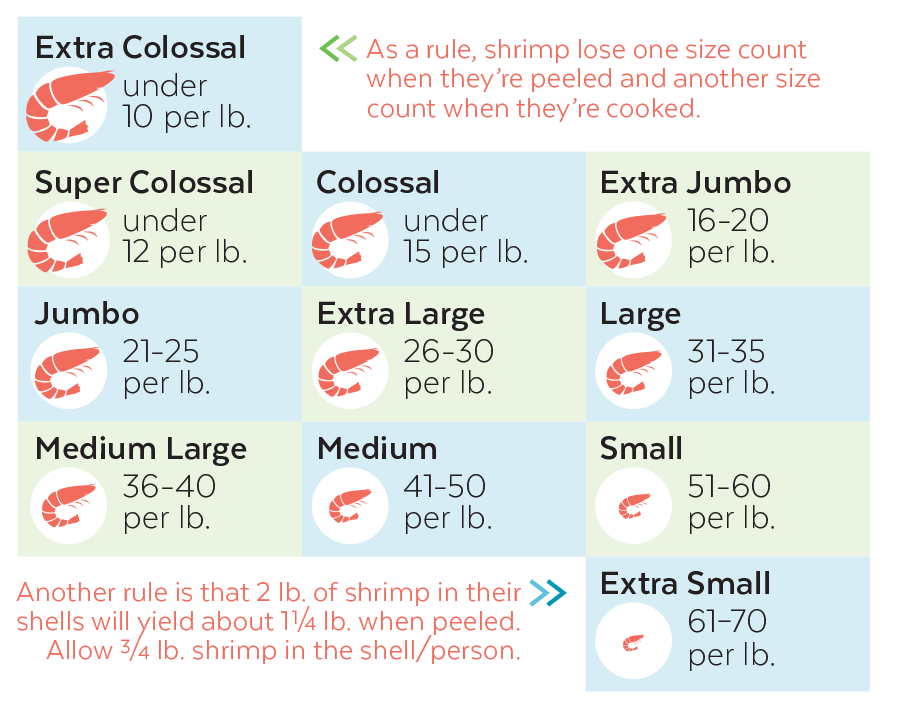
- Extra Colossal: under 10 per lb.
- Super Colossal: under 12 per lb.
- Colossal: under 15 per lb.
- Extra Jumbo: 16-20 per lb.
- Jumbo: 21-25 per lb.
- Extra Large: 26-30 per lb.
- Medium Large: 36-40 per lb.
- Large: 31-35 per lb.
- Medium: 41-50 per lb.
- Small: 51-60 per lb.
- Extra Small: 61–70 per lb.
As a rule, shrimp lose one size count when they’re peeled and another size count when they’re cooked.
Another rule is that 2 lb. of shrimp in their shells will yield about 1¼ lb. when peeled. Allow ¾ lb. shrimp in the shell per person.
HOW TO PEEL & DEVEIN SHRIMP

1 | Grab the legs with your fingertips and peel back the shell up to the tail.
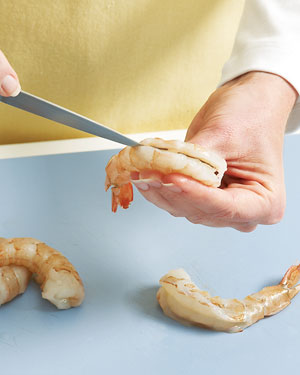
2 | Use the tip of a paring knife to cut a ¼-inch slit down the back.
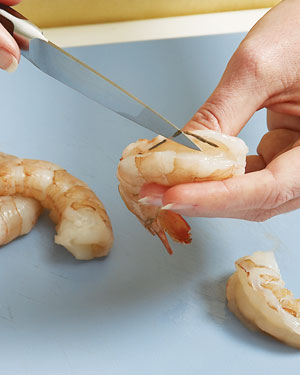
3 | Remove the vein with the tip of the knife, then rinse shrimp in cold water.
HOW TO COOK SHRIMP
The key to cooking shrimp is not to overcook them. That makes them rubbery. How do you know when shrimp are fully cooked? The shells turn pink and the flesh becomes firm and opaque — if needed, you can cut one in half to check. And, leaving them in the shell widens the margin for error and adds flavor.
A FEW OF OUR FAVORITE SHRIMP RECIPES
Product Recommendations
Interested in cooking? Need some supplies?
Check out some of the tools we like. All products featured on Cuisine at Home are independently selected by our editors; we may earn an affiliate commission from qualifying purchases through our links.
